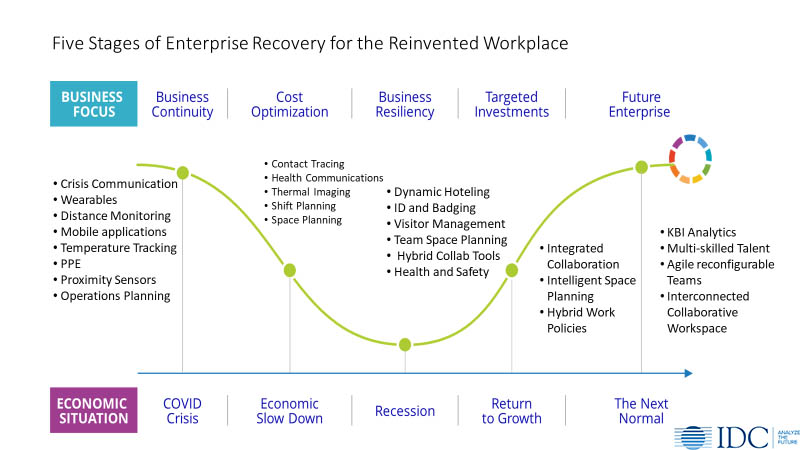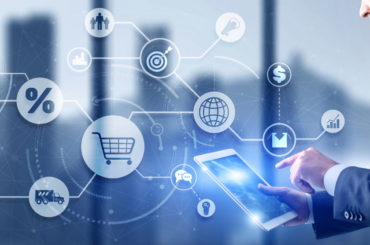As organizations negotiate diverse experiences caused by the global pandemic, they often ask what changes will be temporary and which will be enduring for their work environments. Twitter, Microsoft, Apple, Google and others have publicly declared their intent to rebalance the ratios of in office and remote workers. At IDC, we’ve received many inquiries seeking to determine the ideal balance of remote and on-premise workers. For example, one non-profit client had gone from 5% to 95% of its employees working remotely. And while they don’t anticipate that this will be the status quo for the long term, there is no doubt a much larger percentage of their employees will work remotely moving forward.
In the face of current health and economic challenges, IDC has laid out a 5-stage Enterprise Recovery model to help buyers and vendors alike better strategize a path forward. The graph below shows the 5 stages of enterprise recovery – Business Continuity, Cost Optimization, Business Resilience, Targeted Investments, and Future Enterprise and the technology alignment to promote hybrid work approaches at each step. It is not meant to have a specific timeline so much as a sequence of stages which mark progress or setbacks toward overcoming challenging times. For most organizations, the hybrid work from home model will be the norm for many months to come – if not permanently.

However the reinvented workplace emerges, for each organization there are several key considerations they need to consider. Below, IDC lays out the primary challenges for both employees and their employers. This analysis offers business leaders insight on how to navigate tech spending and organizational change. Enterprise partners in turn will understand what their customers are looking for from solution providers along their journey through recovery to resilience.
Challenges and Tech Investments for the Reinvented Workplace:
- Personal safety and new ways of working for employees. In a slowly evolving hybrid business work environment, new concerns and guidelines for employee safety are adding multiple layers of complexity to an anything but simplest return to the workplace. Before any employee sets foot in the office, space planning applications determine how many employees can safely return to a given space in the building. Thermal imaging devices are programmed to detect elevated temperature levels at scale and communicate with software that triggers secondary scanning protocols.
As employees continue to report and monitor their wellness, privacy protocols must align with new guidance for contact tracing. For those employees in the office, they will encounter all manner of protocols from use of personal protective equipment (PPE), attendance tracking, and evolving legal guidelines for public health and safety. In some ways the return to the workplace will simply feel like an amplication of technological innovation that we are familiar with: touchless elevators and doors, wearables, cleaning robots and enhanced badging that ensures noone who is infected enters the building. In other ways, the changes will seem unfamiliar with frequent reporting, contact tracing, enhanced building navigation applications and sparsely populated meeting spaces. - Personal health and care giver needs, commuting times and office routines of employees. The rapid rise of COVID-19 infections in certain geographies and the very real uncertainties of whether or not children will return to or stay in school during 2H 2020 has added another gating factor for ensuring employees can return to the workplace. HR policies around sick days and remote working that were once considered priviledges are now essential to retain key talent that ensure business continuity.
These challenges are driving employers to revisit their HR policies and any health guidance they are providing to employees. With these specific challenges facing employees comes the need for employers to visit legal requirements related to privacy, health, and safety. To address these challenges, investment in communication, automation, and tele-medicine technologies should be priority for business leaders. - Rapid reskilling of employees for new product offerings. In order to keep innovation moving through crisis and recovery, employers must look to upskill and reskill their employees. IDC has seen a surge in remote learning and digital adoption embedded learning technologies offered as stand alone products and enhanced features of existing offerings. While the days of in person classroom training are likely slow to return, enhancements in video collaboration, AI enabled dynamic learning and journey mapping are filling the void.
On the client side, product development is rapidly accellerating to meet the needs of customers who must shift to cloud-based applications. In some cases companies are dramatically changing what they produce and how they deliver goods and services to accommodate shifting market needs and safety protocols. Behind these go to market, sales and delivery shifts are essential efforts to retrain workers who support these efforts. - Employee communication and engagement in a hybrid work environment. One of the most common challenges employers and employees face in navigating hybrid work arrangements is around communication and collaboration. A frequent question we hear is “What tools will enable my teams to collaborate and communicate effectively with each other regardless of whether they are working in the same room or in completely different parts of the world?” For hybrid teams to work effectively there need to be both new habits of engagement as well as robust adoption of key technologies. Think scheduling tools for structured engagement and instant messaging for unstructured engagement.
From a technology perspective this means offering collaboration platforms that support persistent messaging as well as document sharing, gathering of frequent feedback and behavioral analysis. At an organizational and leadership level, the technologies that must be adopted for the hybrid environment will drive cultural engagement and also provide analytics that can ensure that employees are given sufficient down time to NOT be interrupted so they can focus on key projects in an isolated way when they need to. - Unemployment or furloughed jobs. Clearly, the current crisis is unprecedented and brings with it the need to make very difficult business decisions. Unlike challenging economic crises of the past, this one is less beholden to economic theory than epidemiology. Unlike earlier points in history, we are coming into the current crisis with a keen awareness of the value of highly skilled and highly socially connected employees.
This reality brings an important and challenging responsibility for employers. Employers have new incentives to re-skill or re-assign current employees rather than rely on resource actions as a first resort. Because of the volatile nature of the pandemic waves, employers are also devising re-entry or “re-boarding” programs to enable much more responsive means of rapidly responding to shifting economic conditions. Investment in AI/ML skills analysis, advanced job matching, job sourcing platforms, and social media network analysis are a few of the tools available to offer more nuanced responses to the economic downturn.
When it comes down to it, the rapid acceleration of technology adoption will eventually form the backbone of a far more resilient and agile organization. This future enterprise will be able to withstand the ebb and flows of remote work and its growing role in a new hybrid work model that focuses on people over processes and working solutions over where people are working.




